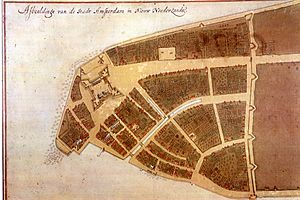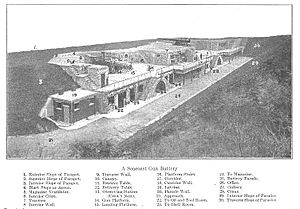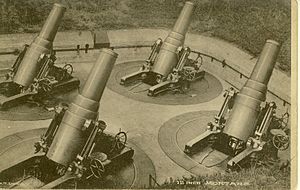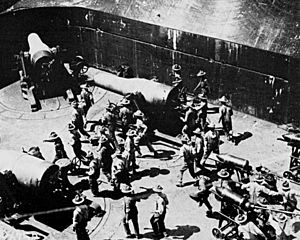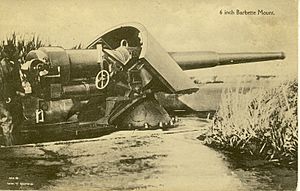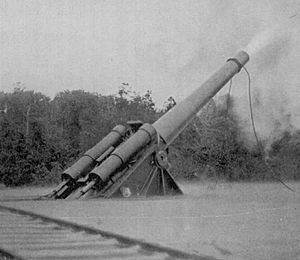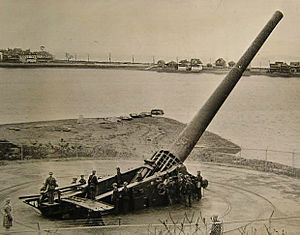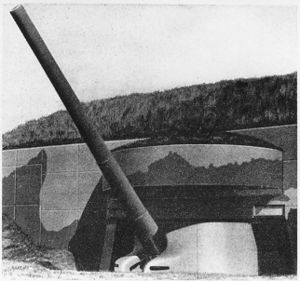Harbor Defenses of New York facts for kids
Quick facts for kids Harbor Defenses of New York |
|
|---|---|
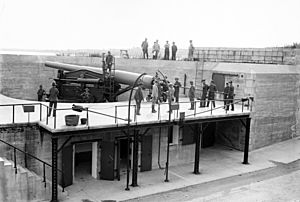
In June 1908, the 10th Company of the 13th Artillery District, New York National Guard (later the 245th Coast Artillery) loads a 10-inch gun at Fort Hamilton in Brooklyn.
|
|
| Active | 1895-1950 |
| Country | |
| Branch | United States Army Coast Artillery Corps |
| Type | Coast artillery |
| Role | Harbor Defense Command |
| Part of |
|
| Garrison/HQ | Fort Hamilton, Brooklyn, New York |
| Mascot(s) | Oozlefinch |
The Harbor Defenses of New York was a special military group in the United States Army Coast Artillery Corps. Its job was to protect New York City from attacks by sea. This defense system was active from 1895 to 1950. It included coast artillery forts and hidden underwater minefields.
The command started around 1895 as different Artillery Districts. In 1913, these became the Coast Defenses of Eastern New York and Coast Defenses of Southern New York. Around 1915, the Coast Defenses of Sandy Hook became a separate command. In 1925, these groups were renamed Harbor Defense Commands. In 1935, the Harbor Defenses of Eastern New York mostly lost its weapons, but might have kept its minefield ability. On May 9, 1942, the New York and Sandy Hook commands, along with the Harbor Defenses of Long Island Sound, joined together to form the unified Harbor Defenses of New York.
Contents
History of New York's Harbor Defenses
Early Forts Protecting New York City
Colonial Times: First Forts in New York
Giovanni da Verrazzano, an Italian explorer working for France, was likely the first European to explore the New York City area in 1524. A Spanish team followed him the next year. In 1542, the French built a fortified trading post called Fort d'Anormée Berge in southern Manhattan. We don't know when it was closed.
Dutch settlement began in 1609 with Henry Hudson, an Englishman working for the Dutch. The Hudson River is named after him. By 1612, a trading post was built in Manhattan. In 1614, Fort Nassau was set up near what is now Albany, New York. This was the first lasting Dutch settlement in the New Netherland colony. The colony grew with fortified settlements to trade for furs.
In 1621, the Dutch West India Company took over New Netherland. After floods, Fort Nassau was replaced by Fort Orange in 1624. That same year, Dutch settlers came to Noten Eylandt (now Governors Island). The next year, they moved to Manhattoes (southern Manhattan) to create New Amsterdam, which is now New York City. They built Fort Amsterdam for protection. In 1653, a wall was added at what is now Wall Street to guard against English attacks.
In 1664, an English force arrived in New York Harbor and demanded the colony surrender. The Dutch leader, Peter Stuyvesant, felt the colony couldn't defend itself. On September 8, he gave New Netherland to the English. The English renamed the city "New York" and the fort "Fort James." This led to the Second Anglo-Dutch War in 1665. The Treaty of Breda in 1667 made the English takeover official. In 1673, the Dutch briefly recaptured New York during the Third Anglo-Dutch War, but the English got it back in 1674.
The Signal Hill site on Staten Island, now Fort Wadsworth, was first fortified by a Dutch settler in 1636. This early fort was destroyed in 1655. Another fort was built in 1663 and was used until 1994, making it the oldest continuously used military site in the Thirteen Colonies.
The fort in Manhattan was renamed Fort George in 1714. In 1699, the wall that Wall Street is named after was taken down. New York City was a British base during the French and Indian War (1754-1763). This war ended the French threat, making colonists less reliant on Britain. In 1765, the British Parliament passed the Stamp Act to help pay for colonial defense. This led to protests like "taxation without representation" and the formation of the Sons of Liberty in New York.
Revolutionary War: Fighting for Freedom
In April 1775, the American Revolution began. In March 1776, American forces captured Boston. General George Washington believed the British would try to take New York. He sent troops there and soon followed himself. Several forts were quickly built in the New York City area in June and July 1776. These included Fort Washington in Manhattan and Fort Lee across the Hudson River. Both were just south of the current George Washington Bridge. A barrier was placed in the Hudson between the forts to stop ships. Other small forts were also built in the city.
On July 3, 1776, the British landed on Staten Island without a fight. They captured Flagstaff Fort, later part of Fort Wadsworth. British forces were led by General Sir William Howe. On July 4, 1776, a small American battery on the site of Fort Hamilton fired at a British warship. The ship was damaged, but the British fleet was too large to stop. Later, on July 12, batteries on Nutten Island fought two British ships, making the British careful about entering the East River.
In late August, the British landed in Brooklyn. On August 27, the Battle of Long Island was fought. This was the largest battle of the Revolution. Washington's forces were pushed back. They secretly retreated across the East River to Manhattan under cover of night and fog.
On September 6, the submarine Turtle made the first recorded submarine attack in history in New York Harbor. This one-person submarine was built by David Bushnell. It tried to attach a mine to a British ship, but failed. The mine later exploded when released.
After the Long Island battle, the British captured General John Sullivan. Admiral Howe used him to send a message to the Continental Congress in Philadelphia. On September 11, the Howe brothers met with John Adams, Benjamin Franklin, and Edward Rutledge at the Staten Island Peace Conference. The Americans demanded independence, but the Howes had no power to grant it. So, the war continued.
On September 15, the British landed in southern Manhattan and quickly took the city. Washington moved his forces north to high ground around Fort Washington. He successfully pushed back a British attack the next day in the Battle of Harlem Heights. The British tried to surround Washington by landing in southeastern Westchester County. Washington moved most of his forces north, fighting the Battle of White Plains on October 28.
In mid-November, Howe returned to Manhattan. He captured Fort Washington, taking 3,000 prisoners. Within days, he also captured Fort Lee. Washington retreated to northern New Jersey. The British then sent troops to capture Newport, Rhode Island.
In early 1777, the British planned to cut off New England by sending a force south from Montreal to Albany. This was supposed to be supported by Howe's forces from New York City. However, Howe decided to capture Philadelphia instead. The Philadelphia campaign was successful, but Burgoyne's northern campaign failed. On October 17, Burgoyne surrendered his army at Saratoga. This victory convinced France to join the war on the American side.
In March 1778, France declared war on Britain. Howe resigned, and Henry Clinton took command. Due to the French naval threat, Clinton was ordered to leave Philadelphia and bring his army to New York City. The British left Philadelphia on June 18. Washington's army followed, fighting the Battle of Monmouth on June 28. By July, Clinton was in New York City, and Washington was back at White Plains, New York. The war then shifted to the southern colonies. The American victory at Yorktown on October 19, 1781, was key to independence. The British left New York City on November 25, 1783, a day remembered as Evacuation Day.
After the Revolution: Building New Defenses
After the war, New York state began building forts before the federal government did. The old Fort Amsterdam was torn down in 1790. The first set of US forts, built around 1794-1800, included Fort Jay on Governors Island and small batteries on Oyster Island (now Ellis Island) and Bedloe's Island (now Liberty Island). These were simple dirt forts. In 1800, New York sold Fort Jay and the islands to the federal government. The federal government then built better stone forts at these locations.
In 1807, a naval incident with Britain caused a war scare, speeding up fort building. This was called the second system of US fortifications. New York Harbor became the most heavily fortified place in the US. This is likely why it was never attacked in the War of 1812. Federal forts included a rebuilt Fort Jay (renamed Fort Columbus around 1806-07) with 60 guns. Castle Williams, a unique circular fort with 78 guns, was built on Governors Island from 1807-1811. The South Battery was added in 1812. Fort Wood (now the base of the Statue of Liberty) was built on Bedloe's Island from 1806-1811 as an 11-pointed star fort. Crown Fort (later Fort Gibson) was built on Oyster Island around 1808. Castle Clinton (initially West Battery) was built in 1809 in Manhattan. The North Battery was completed in Manhattan by 1811.
New York state bought the Signal Hill site on Staten Island in 1806, which later became Fort Wadsworth. The state built four forts there: Fort Richmond (now Battery Weed) and Fort Tompkins, plus Forts Morton and Hudson. These forts could hold 164 guns. Fort Tompkins was mainly for land defense.
The War of 1812 sped up fort construction. Fort Gansevoort was built in Manhattan in 1812. Fort Lafayette, a diamond-shaped stone fort with 72 guns, was started in 1815 near Brooklyn. Many small forts were also built. By the war's end in 1815, over 900 cannons were in the Staten Island area.
1816-1890: Stronger Stone Forts
Even though New York wasn't attacked in the War of 1812, Washington, D.C. was burned due to weak defenses. This led to a new plan for larger stone forts, called the third system of US seacoast fortifications. Building was slow, with many forts unfinished by 1867. New York received six major forts under this plan. Fort Hamilton in Brooklyn was the first, built 1825-1831 to protect Fort Lafayette. Fort Schuyler in the Bronx was built 1833-1856 to defend against attacks from Long Island Sound.
Forts Richmond and Tompkins (in the Fort Wadsworth area) were considered too old by 1835. Work on new forts there began in 1847. The Fort at Sandy Hook in New Jersey (later Fort Hancock) started in 1857. The Fort at Willets Point in Queens (later Fort Totten) began in 1862.
New York City was vital to the Union during the American Civil War. It provided many soldiers and was a major media center. However, the city also saw the New York City draft riots in July 1863, caused by military conscription. At least 120 people died. Troops from the forts likely helped control the riots. A Confederate plot to start fires in the city in November 1864 also occurred. Fort Lafayette and other forts served as prisons for Confederate prisoners. In 1865, Fort Richmond was renamed Fort Wadsworth.
The Civil War showed that stone forts were weak against modern rifled cannons. New earth-protected batteries were built in the 1870s with stronger weapons. One of the first was at Fort at Willets Point. Major Henry Larcom Abbot developed new mortar battery designs and a modern controlled underwater minefield system there. New earth batteries were also built at Fort Wadsworth, Fort Hamilton, and Fort Schuyler. The Sandy Hook Proving Ground was set up near Fort at Sandy Hook in 1874 to test weapons. However, funding for defenses stopped in the late 1870s.
The Endicott Era: Modernizing Defenses (1890s)
In 1885, the Board of Fortifications was formed to suggest new coast defenses. Most of their ideas were used. Construction began in 1890 on new batteries and controlled minefields for New York City. Fort Hancock was the first to start building.
During the 1890s, forts and batteries were officially named. The Fort at Willets Point became Fort Totten. The Fort at Sandy Hook became Fort Hancock. The Signal Hill area became Fort Wadsworth. Fort Columbus was renamed Fort Jay in 1904.
New batteries were also built at Fort Hamilton, Fort Schuyler, and the new Fort Slocum on Davids' Island. About two-thirds of Fort Hamilton was torn down for new batteries. Most of the old Fort at Sandy Hook was removed for Fort Hancock. Forts Hancock, Hamilton, and Wadsworth were part of the Coast Defenses of Southern New York. Forts Schuyler, Totten, and Slocum were part of the Coast Defenses of Eastern New York.
Fort Hancock's first batteries were test models. One was the Gun Lift Battery (later Battery Potter). It used a hydraulic elevator to raise and lower a 12-inch gun. This system was expensive, so Battery Potter was the only one completed. It was disarmed by 1907.
The Sandy Hook Mortar Battery had 16 12-inch mortars. They were arranged in "Abbot Quads," with four mortars in each of four pits. This was meant to hit enemy ships with many shells at once. However, reloading was hard, so later forts had different arrangements. During World War I, two mortars were removed from most pits to make reloading easier.
Fort Hancock also had "Battery Dynamite" from 1896 to 1902. It used compressed air to fire large dynamite-filled shells. But these shells were too slow to hit moving targets, so the weapon was stopped in the early 1900s.
By 1905, the forts had many weapons. Fort Hancock had eight 12-inch guns, sixteen 12-inch mortars, five 10-inch guns, and other smaller guns. Fort Hamilton had six 12-inch guns, eight 12-inch mortars, and many other guns. Fort Wadsworth had eight 12-inch guns, four 10-inch guns, and more.
The Coast Defenses of Eastern New York also had many guns. Fort Slocum had sixteen 12-inch mortars and other guns. Fort Schuyler had two 12-inch guns and two 10-inch guns. Fort Totten had eight 12-inch mortars, two 12-inch guns, and other weapons.
When the Spanish–American War started in 1898, most new batteries were unfinished. Fears of a Spanish attack led to quickly building batteries with medium-caliber guns. Fort Wadsworth and Fort Hamilton each received two 4.72-inch Armstrong guns from the United Kingdom. Fort Wadsworth also got two 6-inch Armstrong guns.
In 1907, Fort Slocum was removed from its command, but kept its guns until World War I. By 1910, Fort Hancock added three 8-inch guns and six 3-inch guns. In 1915, the 8-inch guns at Fort Wadsworth were removed. Before 1917, Fort Hancock became the separate Coast Defenses of Sandy Hook.
World War I: New Roles for Coast Artillery
The Black Tom explosion happened at an ammunition storage area in Jersey City, New Jersey, on July 30, 1916. It broke windows in Manhattan and damaged the Statue of Liberty. This was later found to be sabotage by German agents.
When the United States entered World War I in April 1917, many changes came to the Coast Artillery. Temporary buildings were built at the forts for the wartime mobilization. The Coast Artillery, with its heavy artillery experience, was chosen to operate most US heavy and railway artillery in the war. Many soldiers were sent to the Western Front. Some weapons were removed from forts to be used overseas. 8-inch, 10-inch, and 12-inch guns were made into railway artillery. 5-inch and 6-inch guns became field guns on wheels. 12-inch mortars were also removed from pits to improve reloading.
Few US Army railway artillery pieces saw action before the war ended. The 5-inch and 6-inch guns sent to France didn't finish training in time. Pedestal mounts for 6-inch guns were found to be better than disappearing mounts. Most disappearing guns were removed and stored, many returning in World War II.
Weapons removed from New York City forts included all of Fort Slocum's weapons, some from Fort Schuyler, and many from Fort Totten, Fort Hamilton, and Fort Wadsworth. Only one 5-inch gun was removed from Fort Hancock.
In 1917, one mortar from each pit at Fort Hancock was moved to the new Highlands Military Reservation. Four mortars were removed from Fort Hamilton to create a battery at Camp Rockaway Beach, later Fort Tilden. Two pairs of 6-inch guns were also moved there.
Also in 1917, construction began at Fort Hancock on two new batteries of 12-inch guns on long-range mounts. These were completed in 1921. These long-range guns were developed because battleships were improving quickly.
Between the Wars: Modernizing and Reorganizing
In 1919, the Sandy Hook Proving Ground was closed. The mortars at Camp Rockaway Beach were replaced with railway mortars. By 1923, the mortar batteries at Fort Hancock were disarmed.
During and after World War I, antiaircraft batteries with M1917 3-inch guns were built at some forts. Some of these stayed in service until World War II.
The Coast Artillery developed a new weapon, the 16-inch gun M1919. The first was at Fort Michie. Later, a new mount was developed that allowed the gun to fire at a high angle, maximizing its range. All later 16-inch gun installations used this high-angle mount. HD Southern New York received two of these weapons at Fort Tilden. This new battery was built 1921-1923.
In 1919-1920, several weapon types were declared old and removed from defenses. These included all 5-inch guns, Armstrong guns, and 3-inch M1898 guns.
On July 1, 1924, the harbor defense groups changed from company-based to regiment-based. On June 9, 1925, the commands were renamed from "Coast Defenses..." to "Harbor Defenses...". The 5th Coast Artillery regiment was at HD Southern New York. The 7th Coast Artillery regiment was at HD Sandy Hook. The 245th Coast Artillery regiment was a main New York National Guard group for HD New York.
In 1935, the Harbor Defenses of Eastern New York were mostly disarmed. Fort Schuyler became the State University of New York Maritime College. Fort Slocum had already lost its guns. Fort Totten was disarmed except for four 3-inch guns. Fort Slocum and Fort Totten remained as training posts. Fort Slocum closed in 1965, and Fort Totten in 1974.
World War II: New Threats, New Defenses
At the start of World War II, many temporary buildings were again built at the forts for the quick increase in soldiers and equipment.
After the Fall of France in 1940, the Army decided to replace most old heavy guns with 16-inch guns. In the New York area, this meant one more two-gun battery at the Highlands Military Reservation. This was Battery 116, built in 1942-43 with two 16-inch Mark 2 guns. This battery, along with the 16-inch battery at Fort Tilden and the long-range 12-inch batteries at Fort Hancock, became the main heavy weapons for New York City. All these batteries were protected by heavy concrete covers against air attacks.
The 16-inch batteries were supported by new two-gun 6-inch batteries. These had strong concrete bunkers for ammunition. The guns were protected by open shields. Most of these guns were 6-inch guns stored since World War I. Three of these batteries were built in the New York area, but only one, Battery 219, was armed.
Six 90 mm gun Anti-Motor Torpedo Boat (AMTB) batteries were built in New York City. These guns could fire at both surface ships and aircraft. Each battery had fixed and towed 90 mm guns, and 40 mm Bofors guns.
As new defenses were built, most older guns were scrapped in 1942-43. However, some 6-inch and 3-inch guns remained.
After mobilization in 1940, the HD New York commands were under First Army. On December 24, 1941, the Eastern Defense Command was created, overseeing all east coast harbor defense commands. Its headquarters was also at Fort Jay. This command closed in 1946. On May 4, 1942, the Harbor Defenses of Long Island Sound joined the Harbor Defenses of New York. On May 9, 1942, HD Southern New York merged with HD Sandy Hook and part of HD Eastern New York to form the Harbor Defenses of New York. These older commands were officially closed on May 22, 1944.
The 265th Coast Artillery Regiment was at Fort Hancock from February to June 1943.
The US Navy also helped defend New York with net defenses and submarine-detecting systems.
After the war, it was clear that gun defenses were old-fashioned. They were scrapped by 1948. In 1950, the Coast Artillery Corps and all Army harbor defense commands were dissolved. Today, the Air Defense Artillery continues the history of some Coast Artillery units. 90 mm and 120 mm antiaircraft guns were placed around New York in the late 1940s, followed by Nike missile systems in the 1950s. These missile systems used many of the old fort sites. The Nike missiles were removed in the early 1970s.
What Remains Today
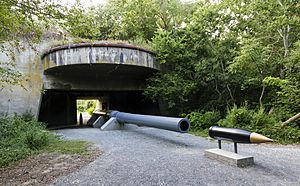
Fort Wadsworth, Fort Tilden, and Fort Hancock are now part of the Gateway National Recreation Area. They are managed by the National Park Service and are open to the public. Fort Jay and Castle Williams are in Governors Island National Monument, also a national park. They have Civil War-era cannons and signs explaining their history.
The old fort at Fort Schuyler is now office space for the State University of New York Maritime College. The fort is well-preserved, but the newer Endicott batteries are gone or buried. A magazine and a buried mine control room remain. Fort Slocum has mostly been torn down. However, a 15-inch Rodman gun and three mortar pits remain. Fort Totten is partly used by the Army Reserve. The stone fort is open to the public, but the preserved Endicott batteries are not. The minefield control area is still there but used by the New York Police Department. The old Fort Totten Officers' Club is now home to the Bayside Historical Society.
Fort Wood is the base for the Statue of Liberty. Fort Gibson on Ellis Island was torn down in 1892 to build the immigration station. A plaque on the island remembers it. Castle Clinton is still standing and used for concerts. Fort Gansevoort was torn down in 1854, and the North Battery is also gone. Fort Lafayette was demolished in 1960 to make way for the Verrazano-Narrows Bridge.
Fort Hamilton is the last active Army post in New York City. Several weapons are displayed there, including an experimental 20-inch Rodman gun. Only about a third of the old fort remains. The fort's remaining caponier houses the Army's Harbor Defense Museum.
Most of the Endicott batteries at Fort Wadsworth are buried. However, parts of Battery Duane, an 8-inch battery from 1915, are still there. The third system forts Battery Weed and Fort Tompkins are also intact. Battery Weed and Fort Tompkins can only be visited on a tour.
Fort Tilden's 16-inch battery can be seen but not entered.
Fort Hancock has one of the largest collections of preserved Endicott batteries. This includes the dynamite gun battery and a test battery for 14-inch guns. Many of the old buildings remain. A 20-inch Rodman gun and a 10-inch Rodman gun are on display. Two rare 6-inch M1900 guns are at Battery New Peck (also called Battery Gunnison). Only a small part of the third system fort's wall remains. Nike Site NY-56 is partly preserved with a radar area and display missiles. The Highlands Military Reservation is now Hartshorne Woods Park. A Navy 16"/50 caliber Mark 7 gun is displayed at one of the 16-inch casemates.
Coats of Arms
Harbor Defenses of Eastern New York
- Symbolism: Fort Totten was once home to the Engineer School. The green chevron and its symbols show this history. The crest, with a star and a sword, represents the power of command.
- Motto: The motto Sic Vis Pacem, Para Bellum means "If you want peace, prepare for war."
Harbor Defenses of Southern New York
- Symbolism: The beaver on the crest is a symbol of New York, found on the old arms of New Netherland and now on the seal of New York City. The shield represents the Battle of Long Island in 1776, near Fort Hamilton. The design shows how Washington's clever retreat saved his army after the battle. The three bars stand for the three enemy forces. The lion represents the American forces breaking through a British command.
- Motto: The motto Volens et Potens means "Willing and Able."
Coast Defenses of Sandy Hook
- Symbolism: The shield is red and gold, with a jagged line between them. On the red part is the Statue of Liberty in gold. On the gold part is the Sandy Hook lighthouse between two bursting shells. The lighthouse and shells are black, with natural fire flames. The crest is a gold panther breathing fire on a red tower. The shield is shown in front of Henry Hudson's ship, the Half Moon, to remember his exploration of New York Bay.
- Motto: The motto Obscurata Lucidior means "Dimmed yet Brighter." It refers to how the darkening of the lighthouse helped show the light of liberty in the country.
- Background: This coat of arms was approved in 1919. The gold panther crest was adopted by the 7th Coast Artillery Regiment in 1924.


